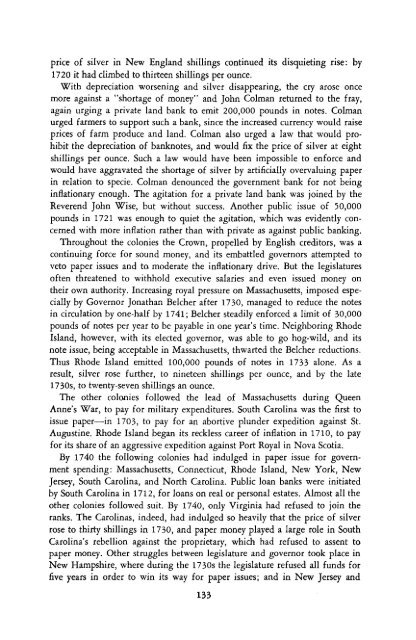Conceived in Liberty Volume 2 - Ludwig von Mises Institute
Conceived in Liberty Volume 2 - Ludwig von Mises Institute
Conceived in Liberty Volume 2 - Ludwig von Mises Institute
Create successful ePaper yourself
Turn your PDF publications into a flip-book with our unique Google optimized e-Paper software.
price of silver <strong>in</strong> New England shill<strong>in</strong>gs cont<strong>in</strong>ued its disquiet<strong>in</strong>g rise: by<br />
1720 it had climbed to thirteen shill<strong>in</strong>gs per ounce.<br />
With depreciation worsen<strong>in</strong>g and silver disappear<strong>in</strong>g, the cry arose once<br />
more aga<strong>in</strong>st a "shortage of money" and John Colman returned to the fray,<br />
aga<strong>in</strong> urg<strong>in</strong>g a private land bank to emit 200,000 pounds <strong>in</strong> notes. Colman<br />
urged farmers to support such a bank, s<strong>in</strong>ce the <strong>in</strong>creased currency would raise<br />
prices of farm produce and land. Colman also urged a law that would prohibit<br />
the depreciation of banknotes, and would fix the price of silver at eight<br />
shill<strong>in</strong>gs per ounce. Such a law would have been impossible to enforce and<br />
would have aggravated the shortage of silver by artificially overvalu<strong>in</strong>g paper<br />
<strong>in</strong> relation to specie. Colman denounced the government bank for not be<strong>in</strong>g<br />
<strong>in</strong>flationary enough. The agitation for a private land bank was jo<strong>in</strong>ed by the<br />
Reverend John Wise, but without success. Another public issue of 50,000<br />
pounds <strong>in</strong> 1721 was enough to quiet the agitation, which was evidently concerned<br />
with more <strong>in</strong>flation rather than with private as aga<strong>in</strong>st public bank<strong>in</strong>g.<br />
Throughout the colonies the Crown, propelled by English creditors, was a<br />
cont<strong>in</strong>u<strong>in</strong>g force for sound money, and its embattled governors attempted to<br />
veto paper issues and to moderate the <strong>in</strong>flationary drive. But the legislatures<br />
often threatened to withhold executive salaries and even issued money on<br />
their own authority. Increas<strong>in</strong>g royal pressure on Massachusetts, imposed especially<br />
by Governor Jonathan Belcher after 1730, managed to reduce the notes<br />
<strong>in</strong> circulation by one-half by 1741; Belcher steadily enforced a limit of 30,000<br />
pounds of notes per year to be payable <strong>in</strong> one year's time. Neighbor<strong>in</strong>g Rhode<br />
Island, however, with its elected governor, was able to go hog-wild, and its<br />
note issue, be<strong>in</strong>g acceptable <strong>in</strong> Massachusetts, thwarted the Belcher reductions.<br />
Thus Rhode Island emitted 100,000 pounds of notes <strong>in</strong> 1733 alone. As a<br />
result, silver rose further, to n<strong>in</strong>eteen shill<strong>in</strong>gs per ounce, and by the late<br />
1730s, to twenty-seven shill<strong>in</strong>gs an ounce.<br />
The other colonies followed the lead of Massachusetts dur<strong>in</strong>g Queen<br />
Anne's War, to pay for military expenditures. South Carol<strong>in</strong>a was the first to<br />
issue paper—<strong>in</strong> 1703, to pay for an abortive plunder expedition aga<strong>in</strong>st St.<br />
August<strong>in</strong>e. Rhode Island began its reckless career of <strong>in</strong>flation <strong>in</strong> 1710, to pay<br />
for its share of an aggressive expedition aga<strong>in</strong>st Port Royal <strong>in</strong> Nova Scotia.<br />
By 1740 the follow<strong>in</strong>g colonies had <strong>in</strong>dulged <strong>in</strong> paper issue for government<br />
spend<strong>in</strong>g: Massachusetts, Connecticut, Rhode Island, New York, New<br />
Jersey, South Carol<strong>in</strong>a, and North Carol<strong>in</strong>a. Public loan banks were <strong>in</strong>itiated<br />
by South Carol<strong>in</strong>a <strong>in</strong> 1712, for loans on real or personal estates. Almost all the<br />
other colonies followed suit. By 1740, only Virg<strong>in</strong>ia had refused to jo<strong>in</strong> the<br />
ranks. The Carol<strong>in</strong>as, <strong>in</strong>deed, had <strong>in</strong>dulged so heavily that the price of silver<br />
rose to thirty shill<strong>in</strong>gs <strong>in</strong> 1730, and paper money played a large role <strong>in</strong> South<br />
Carol<strong>in</strong>a's rebellion aga<strong>in</strong>st the proprietary, which had refused to assent to<br />
paper money. Other struggles between legislature and governor took place <strong>in</strong><br />
New Hampshire, where dur<strong>in</strong>g the 1730s the legislature refused all funds for<br />
five years <strong>in</strong> order to w<strong>in</strong> its way for paper issues; and <strong>in</strong> New Jersey and<br />
133
















